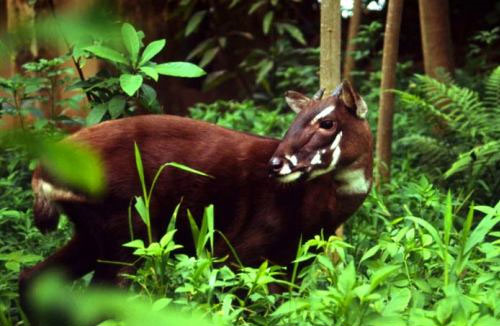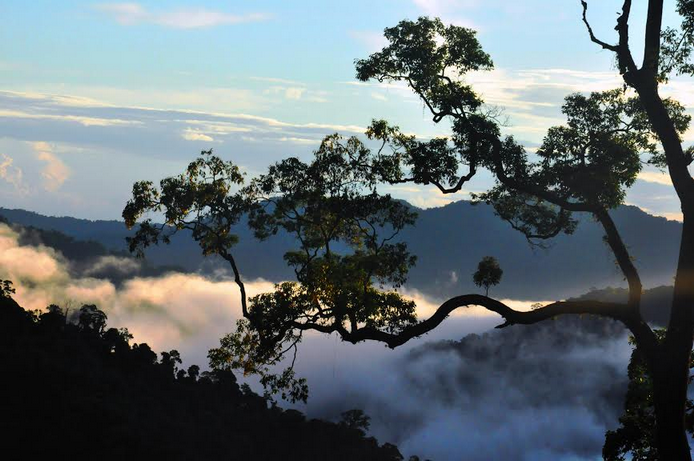

10/01/2018
The Thua Thien-Hue Preservation Park of Saola (known as siola, Vu Quang ox, spindlehorn or Asian bicorn) boasts of a unique biodiversity.
Founded in 2013, the park has a total area of over 15,500 hectares and is located in the 3 communes of Huong Nguyen (A Luoi District), Thuong Quang and Thuong Long (both in Nam Dong District).
 |
| The first saola individual was founded in the province of Thua Thien-Hue in 1998 |
HOME TO RARE ANIMALS
The Thua Thien-Hue Preservation Park of Saola comprises 200 kinds of animals and plants. The park is covered with a large area of tropical forest, and is home to many rare animals and birds, primitive forest, waterfalls and abysses.
Besides, it is also home to animals recognized for their value across the world, such as the giant muntjac and Truong Son muntjac. The park is also home to the saola - One of the most mysterious animals in the world. Being discovered in 1992 in a joint survey that was carried out by a group of scientists from the Vietnam Ministry of Forestry (now the Ministry of Agriculture and Rural Development) and the World Wildlife Fund (WWF) at the Hà Tĩnh Province’s Vu Quang National Park, the saola lived along the Truong Son Mountains (Annamite Range). That was the world’s first large mammal discovery in over 50 years and one of the most spectacular zoological discoveries of the 20th century.
 |
| The view of the Thua Thien-Hue Saola Preservation Park |
Saola is a kind of hollow-horn animal, similar to an antelope. This species is also called the Asian bicorn, recognized by 2 parallel horns with sharp ends, which can reach 50cm in length. The International Union for Conservation of Nature’s (IUCN) Red List of Threatened Species and Việt Nam have termed the saola as an animal in very high threat of extinction. At the moment, the saola population is estimated at below 250 across the world, while the actual number might be much lower. In the province of Thua Thien-Hue, two saolas were found in 1998, marking an important stage for the allocation of the species in the province’s biodiversity map. One of the two was a 52kg male in the Ho Hamlet, Duong Hoa Commune, Huong Thuy District, and the other was an 80kg pregnant female in the forest of Huong Nguyen Commune, A Luoi District. In 1999, a 10kg baby saola appeared in But Hamlet, Huong Nguyen Commune. The findings have made a great contribution to both Việt Nam and the world’s biodiversity conservation.
EFFORTS IN BIODIVERSITY CONSERVATION UNDERWAY
On March 30, 2014, the People’s Committee of Thua Thien-Hue Province decided to establish the Saola Preservation Park Ranger County and put the force under direct management of the province’s forest ranger. The county is responsible for preserving the saola community, the two ungulate mammals - giant muntjac and Truong Son muntjac - and other rare animals and plants, protecting the primitive forest area that is left in the Truong Son Range’s middle region, carrying out biodiversity conservation activities and preserving species, genes and the environment of the forest area.
To prevent saola and other animals from being trapped by hunters, forest rangers were hired, with support of the WWF. In the five years of their deployment, the rangers have patrolled and disassembled 60,000 traps, destroyed dozens of illegal camps, saved and released a lot of rare animals such as leaf monkeys, Truong Son muntjac and chamois. These have been some of the remarkable efforts of the rangers in preserving wild animals and protecting the forest environment.
In addition to patrolling to protect the forest, rangers have worked with specialists to monitor the biodiversity system, carried out surveys and research, maintained the 50 camera trap programme to track rare animals and collected samples of turd and leech blood. These actions have helped discover a lot of rare animals such as striped rabbit, giant muntjac and Truong Son muntjac, marking important steps for preserving the saola in particular and the biodiversity system in general in Việt Nam.
Despite having achieved some success in biodiversity conservation, challenges have remained for the Thua Thien-Hue Saola Preservation Park. The question is, how can the local authorities balance socio-economic development benefits and protect primitive forests - home to wild animals? Hopefully, the preservation park will remain the ideal habitat for wild animals in the near future.
Hoa Vũ
Vietnam National University of Forestry